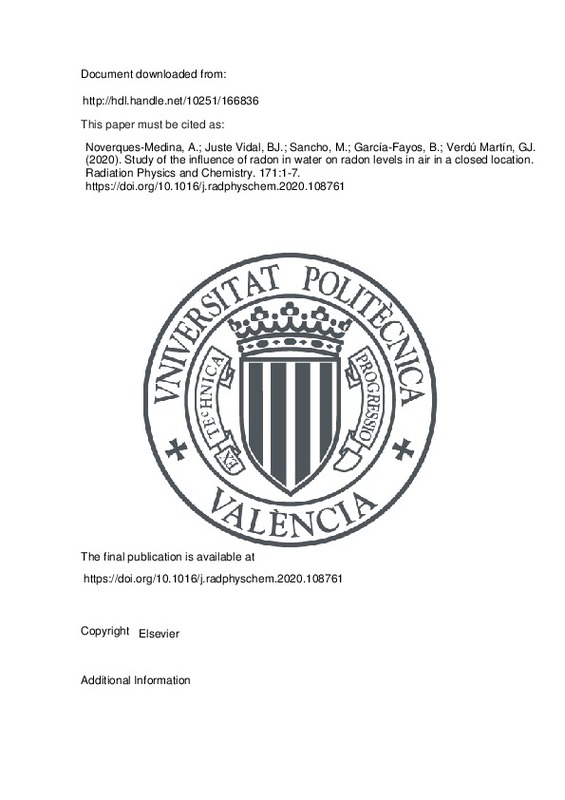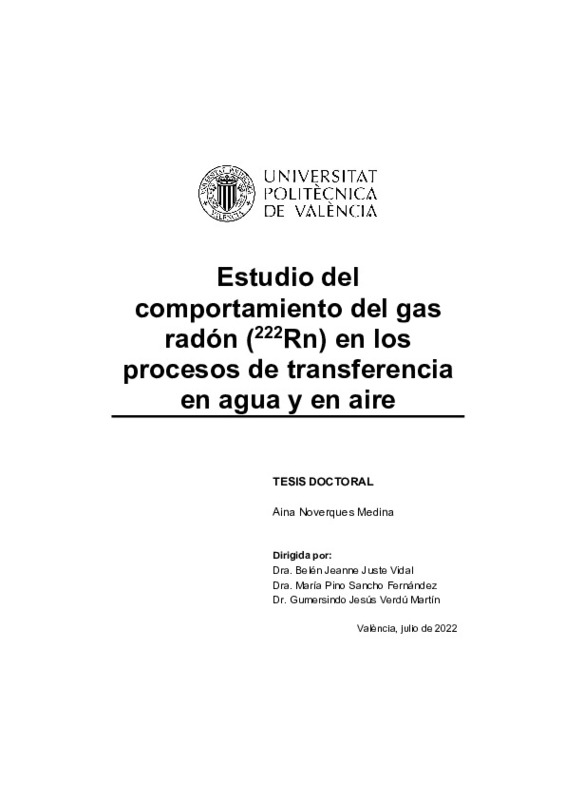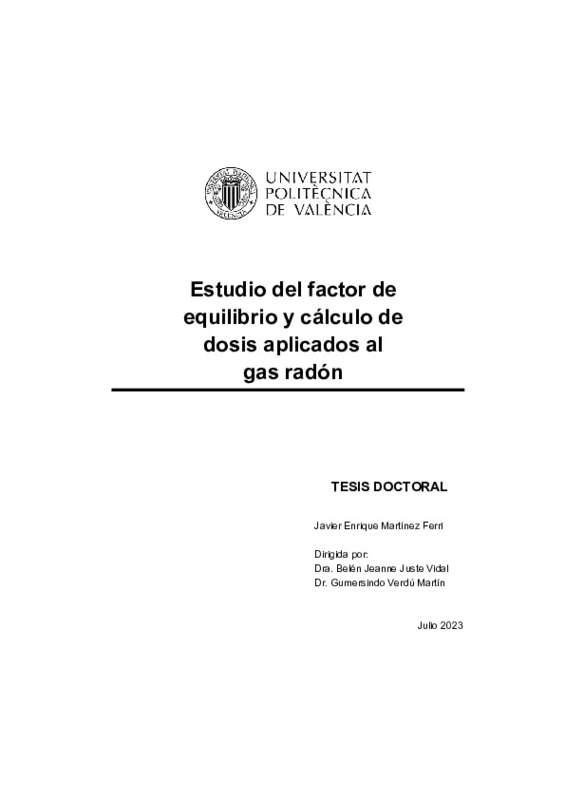JavaScript is disabled for your browser. Some features of this site may not work without it.
Buscar en RiuNet
Listar
Mi cuenta
Estadísticas
Ayuda RiuNet
Admin. UPV
Study of the influence of radon in water on radon levels in air in a closed location
Mostrar el registro sencillo del ítem
Ficheros en el ítem
| dc.contributor.author | Noverques-Medina, Aina
|
es_ES |
| dc.contributor.author | Juste Vidal, Belen Jeanine
|
es_ES |
| dc.contributor.author | Sancho, M.
|
es_ES |
| dc.contributor.author | García-Fayos, Beatriz
|
es_ES |
| dc.contributor.author | Verdú Martín, Gumersindo Jesús
|
es_ES |
| dc.date.accessioned | 2021-05-27T03:34:43Z | |
| dc.date.available | 2021-05-27T03:34:43Z | |
| dc.date.issued | 2020-06 | es_ES |
| dc.identifier.issn | 0969-806X | es_ES |
| dc.identifier.uri | http://hdl.handle.net/10251/166836 | |
| dc.description.abstract | [EN] Radon, radioactive gas that comes from uranium and radium decay was considered as a carcinogenic element by the World Health Organization in 1988. The hazard of this gas resides in two of its descendants, the Po-214 and Po-218, solid particles that adhere to the aerosols present in the air and are deposited in human lungs causing damage to its tissue. In closed spaces, radon tends to accumulate in the air reaching levels above the legislative limits established in the Directive 59/2019/EURATOM. However, radon is present not only in the air but also in soil, water and building materials. In this research it has been investigated water as a radon source. Due to its high variability, the main objective of this research is to study the influence of water radon concentration into air radon concentration in two situations: at a laboratory scale and in a real installation. For this purpose, an experimental device was designed at laboratory scale to analyze this influence in stable conditions of temperature, relative humidity and atmospheric pressure, thus reducing the interference of these variables in radon measurements. For field measurements, the radon levels in water and its possible influence on the increase in air concentration in a Waste Water Pre-Treatment Plant (WWPTP) have been analyzed. | es_ES |
| dc.description.sponsorship | This work has been funded by two projects: BIORAD and DESARROLLO DE METODOLOGIAS DE PREVENCION Y DE MODELOS DE DOSIMETRIA INTERNA PARA LAS RADIACIONES IONIZANTES RELACIONADAS CON MATERIALES NORM (MEMO RADION) of the ISIRYM University Institute in the framework of the Operational Programme 2014-2020 Comunitat Valenciana of the European Regional Development Fund, with reference IDIFEDER/2018/038. | es_ES |
| dc.language | Inglés | es_ES |
| dc.publisher | Elsevier | es_ES |
| dc.relation.ispartof | Radiation Physics and Chemistry | es_ES |
| dc.rights | Reconocimiento - No comercial - Sin obra derivada (by-nc-nd) | es_ES |
| dc.subject | Radon in water | es_ES |
| dc.subject | Radon influence in air | es_ES |
| dc.subject | RadonScout plus | es_ES |
| dc.subject | Corentium pro | es_ES |
| dc.subject | Hidex 600 SL | es_ES |
| dc.subject.classification | INGENIERIA NUCLEAR | es_ES |
| dc.subject.classification | INGENIERIA QUIMICA | es_ES |
| dc.title | Study of the influence of radon in water on radon levels in air in a closed location | es_ES |
| dc.type | Artículo | es_ES |
| dc.type | Comunicación en congreso | es_ES |
| dc.identifier.doi | 10.1016/j.radphyschem.2020.108761 | es_ES |
| dc.relation.projectID | info:eu-repo/grantAgreement/GVA//IDIFEDER%2F2018%2FA%2F038/ES/DESARROLLO DE METODOLOGÍAS DE PREVENCIÓN Y DE MODELOS DE DOSIMETRÍA INTERNA PARA LAS RADIACIONES IONIZANTES RELACIONADAS CON MATERIALES NORM (MEMO RADIÓN)/ | es_ES |
| dc.rights.accessRights | Abierto | es_ES |
| dc.contributor.affiliation | Universitat Politècnica de València. Departamento de Ingeniería Química y Nuclear - Departament d'Enginyeria Química i Nuclear | es_ES |
| dc.contributor.affiliation | Universitat Politècnica de València. Instituto de Seguridad Industrial, Radiofísica y Medioambiental - Institut de Seguretat Industrial, Radiofísica i Mediambiental | es_ES |
| dc.description.bibliographicCitation | Noverques-Medina, A.; Juste Vidal, BJ.; Sancho, M.; García-Fayos, B.; Verdú Martín, GJ. (2020). Study of the influence of radon in water on radon levels in air in a closed location. Radiation Physics and Chemistry. 171:1-7. https://doi.org/10.1016/j.radphyschem.2020.108761 | es_ES |
| dc.description.accrualMethod | S | es_ES |
| dc.relation.conferencename | 3rd International Conference on Dosimetry and its Applications (ICDA-3) | es_ES |
| dc.relation.conferencedate | Mayo 27-31,2019 | es_ES |
| dc.relation.conferenceplace | Lisbon, Portugal | es_ES |
| dc.relation.publisherversion | https://doi.org/10.1016/j.radphyschem.2020.108761 | es_ES |
| dc.description.upvformatpinicio | 1 | es_ES |
| dc.description.upvformatpfin | 7 | es_ES |
| dc.type.version | info:eu-repo/semantics/publishedVersion | es_ES |
| dc.description.volume | 171 | es_ES |
| dc.relation.pasarela | S\408319 | es_ES |
| dc.contributor.funder | Generalitat Valenciana | es_ES |
| dc.contributor.funder | Universitat Politècnica de València | es_ES |
| dc.description.references | Battino, R. (1984). The Ostwald coefficient of gas solubility. Fluid Phase Equilibria, 15(3), 231-240. doi:10.1016/0378-3812(84)87009-0 | es_ES |
| dc.description.references | Baudron, P., Cockenpot, S., Lopez-Castejon, F., Radakovitch, O., Gilabert, J., Mayer, A., … Claude, C. (2015). Combining radon, short-lived radium isotopes and hydrodynamic modeling to assess submarine groundwater discharge from an anthropized semiarid watershed to a Mediterranean lagoon (Mar Menor, SE Spain). Journal of Hydrology, 525, 55-71. doi:10.1016/j.jhydrol.2015.03.015 | es_ES |
| dc.description.references | Kowalczk, A. J., & Froelich, P. N. (2010). Cave air ventilation and CO2 outgassing by radon-222 modeling: How fast do caves breathe? Earth and Planetary Science Letters, 289(1-2), 209-219. doi:10.1016/j.epsl.2009.11.010 | es_ES |
| dc.description.references | Moreno, V., Bach, J., Baixeras, C., & Font, L. (2014). Radon levels in groundwaters and natural radioactivity in soils of the volcanic region of La Garrotxa, Spain. Journal of Environmental Radioactivity, 128, 1-8. doi:10.1016/j.jenvrad.2013.10.021 | es_ES |
| dc.description.references | Nussbaum, E., & Harsh, J. B. (1958). Radon Solubility in Fatty Acids and Triglycerides. The Journal of Physical Chemistry, 62(1), 81-84. doi:10.1021/j150559a021 | es_ES |
| dc.description.references | Prichard, H. M., & Gesell, T. F. (1977). Rapid Measurements of 222Rn Concentrations in Water With a Commercial Liquid Scintillation Counter. Health Physics, 33(6), 577-581. doi:10.1097/00004032-197712000-00008 | es_ES |
| dc.description.references | Ródenas, C., Gómez, J., Soto, J., & Maraver, F. (2008). Natural radioactivity of spring water used as spas in Spain. Journal of Radioanalytical and Nuclear Chemistry, 277(3), 625-630. doi:10.1007/s10967-007-7158-3 | es_ES |
| dc.description.references | Sainz, C., Rábago, D., Fuente, I., Celaya, S., & Quindós, L. S. (2016). Description of the behavior of an aquifer by using continuous radon monitoring in a thermal spa. Science of The Total Environment, 543, 460-466. doi:10.1016/j.scitotenv.2015.11.052 | es_ES |
| dc.description.references | Schubert, M., Paschke, A., Lieberman, E., & Burnett, W. C. (2012). Air–Water Partitioning of 222Rn and its Dependence on Water Temperature and Salinity. Environmental Science & Technology, 46(7), 3905-3911. doi:10.1021/es204680n | es_ES |
| dc.description.references | SOTO, J., FERNANDEZ, P., QUINDOS, L., & GOMEZAROZAMENA, J. (1995). Radioactivity in Spanish spas. Science of The Total Environment, 162(2-3), 187-192. doi:10.1016/0048-9697(95)04454-9 | es_ES |
| dc.description.references | User Manual Radon Scout Plus, (2017) Sarad Company. | es_ES |







![[Cerrado]](/themes/UPV/images/candado.png)



